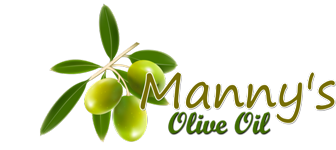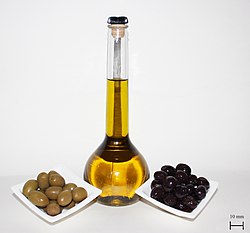
Extra virgin olive oil presented with green and black preserved table olives
|
|
| Fat composition | |
|---|---|
| Saturated fats | |
| Total saturated | Palmitic acid: 13.0% Stearic acid: 1.5% |
| Unsaturated fats | |
| Total unsaturated | > 85% |
| Monounsaturated | Oleic acid: 70.0% Palmitoleic acid: 0.3–3.5% |
| Polyunsaturated | Linoleic acid: 15.0% α-Linolenic acid: 0.5% |
| Properties | |
| Food energy per 100 g (3.5 oz) | 3,700 kJ (880 kcal) |
| Melting point | −6.0 °C (21.2 °F) |
| Boiling point | 299 °C (570 °F) |
| Smoke point | 190–215 °C (374–419 °F) (extra virgin)[1] 215 °C (419 °F) (virgin)[2] 210 °C (410 °F) (refined) |
| Solidity at 20 °C (68 °F) | Liquid |
| Specific gravity at 20 °C (68 °F) | 0.911[3] |
| Viscosity at 20 °C (68 °F) | 84 cP |
| Refractive index | 1.4677–1.4705 (virgin and refined) 1.4680–1.4707 (pomace) |
| Iodine value | 75–94 (virgin and refined) 75–92 (pomace) |
| Acid value | maximum: 6.6%[inconsistent](refined and pomace) 0.8% (extra virgin) |
| Saponification value | 184–196 (virgin and refined) 182–193 (pomace) |
| Peroxide value | 20 (virgin) 10 (refined and pomace) |
Olive oil is a liquid fat obtained by pressing whole olives, the fruit of Olea europaea, a traditional tree crop of the Mediterranean Basin, and extracting the oil.
It is commonly used in cooking for frying foods or as a salad dressing. It can also be found in some cosmetics, pharmaceuticals, soaps, and fuels for traditional oil lamps. It also has additional uses in some religions. The olive is one of three core food plants in Mediterranean cuisine, together with wheat and grapes. Olive trees have been grown around the Mediterranean since the 8th millennium BC.
Spain is the world’s largest producer, manufacturing almost half of the world’s olive oil. Other large producers are Italy, Greece, Tunisia, Turkey and Morocco.
The composition of olive oil varies with the cultivar, altitude, time of harvest, and extraction process. It consists mainly of oleic acid (up to 83%), with smaller amounts of other fatty acids including linoleic acid (up to 21%) and palmitic acid (up to 20%). Extra virgin olive oil is required to have no more than 0.8% free acidity and is considered to have favorable flavor characteristics.
History[edit]
Olive oil has long been a common ingredient in Mediterranean cuisine, including ancient Greek and Roman cuisine. Wild olives, which originated in Asia Minor, were collected by Neolithic people as early as the 8th millennium BC.[4][5] Besides food, olive oil has been used for religious rituals, medicines, as a fuel in oil lamps, soap-making, and skincare application.[citation needed] The Spartans and other Greeks used oil to rub themselves while exercising in the gymnasia. From its beginnings early in the 7th century BC, the cosmetic use of olive oil quickly spread to all of the Hellenic city-states, together with athletes training in the nude, and lasted close to a thousand years despite its great expense.[6][7] Olive oil was also popular as a form of birth control; Aristotle in his History of Animals recommends applying a mixture of olive oil combined with either oil of cedar, ointment of lead, or ointment of frankincense to the cervix to prevent pregnancy.[8]
Early cultivation[edit]
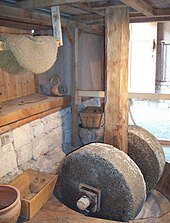
It is not clear when and where olive trees were first domesticated. The modern olive tree may have originated in ancient Persia and Mesopotamia and spread to the Levant and later to North Africa, though some scholars argue for an Egyptian origin.[9]
The olive tree reached Greece, Carthage and Libya sometime in the 28th century BC, having been spread westward by the Phoenicians.[9] Until around 1500 BC, eastern coastal areas of the Mediterranean were most heavily cultivated.[citation needed] Evidence also suggests that olives were being grown in Crete as long ago as 2500 BC. The earliest surviving olive oil amphorae date to 3500 BC (Early Minoan times), though the production of olive oil is assumed to have started before 4000 BC.[10] Olive trees were certainly cultivated by the Late Minoan period (1500 BC) in Crete, and perhaps as early as the Early Minoan.[11] The cultivation of olive trees in Crete became particularly intense in the post-palatial period and played an important role in the island’s economy, as it did across the Mediterranean.[12] Later, as Greek colonies were established in other parts of the Mediterranean, olive farming was introduced to places like Spain and continued to spread throughout the Roman Empire.[9]
Olive trees were introduced to the Americas in the 16th century when cultivation began in areas that enjoyed a climate similar to the Mediterranean such as Chile, Argentina, and California.[9]
Recent genetic studies suggest that species used by modern cultivators descend from multiple wild populations, but detailed history of domestication is unknown.[13]
Trade and production[edit]
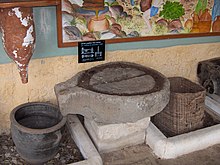
Archaeological evidence in Galilee, Israel, shows that by 6000 BC olives were being turned into olive oil[14] and in 4500 BC at a now-submerged prehistoric settlement south of Haifa, Israel.[15]
Olive trees and oil production in the Eastern Mediterranean can be traced to archives of the ancient city-state Ebla (2600–2240 BC), which were located on the outskirts of the Syrian city Aleppo. Here some dozen documents dated 2400 BC describe the lands of the king and the queen. These belonged to a library of clay tablets perfectly preserved by having been baked in the fire that destroyed the palace. A later source is the frequent mentions of oil in the Tanakh.[16]
Dynastic Egyptians before 2000 BC imported olive oil from Crete, Syria and, Canaan and oil was an important item of commerce and wealth. Remains of olive oil have been found in jugs over 4,000 years old in a tomb on the island of Naxos in the Aegean Sea. Sinuhe, the Egyptian exile who lived in northern Canaan c. 1960 BC, wrote of abundant olive trees.[17] The Minoans used olive oil in religious ceremonies. The oil became a principal product of the Minoan civilization, where it is thought to have represented wealth.[18]
Olive oil was also a major export of Mycenaean Greece (c. 1450–1150 BC).[19][9] Scholars believe the oil was made by a process where olives were placed in woven mats and squeezed. The oil was collected in vats. This process was known from the Bronze Age, was used by the Egyptians and continued to be used through the Hellenistic period.[9]

The importance of olive oil as a commercial commodity increased after the Roman conquest of Egypt, Greece and Asia Minor led to more trade along the Mediterranean. Olive trees were planted throughout the entire Mediterranean basin during evolution of the Roman Republic and Empire. According to the historian Pliny the Elder, Italy had “excellent olive oil at reasonable prices” by the 1st century AD—”the best in the Mediterranean”.[citation needed] As olive production expanded in the 5th century AD the Romans began to employ more sophisticated production techniques like the olive press and trapetum (pictured left).[9] Many ancient presses still exist in the Eastern Mediterranean region, and some dating to the Roman period are still in use today.[20] Productivity was greatly improved by Joseph Graham’s development of the hydraulic pressing system developed in 1795.[9]

Symbolism and mythology[edit]
The olive tree has historically been a symbol of peace between nations. It has played a religious and social role in Greek mythology, especially concerning the name of the city of Athens where the city was named after the goddess Athena because her gift of an olive tree was held to be more precious than rival Poseidon‘s gift of a salt spring.[9]
Varieties[edit]
There are many olive cultivars, each with a particular flavor, texture, and shelf life that make them more or less suitable for different applications, such as direct human consumption on bread or in salads, indirect consumption in domestic cooking or catering, or industrial uses such as animal feed or engineering applications.[21] During the stages of maturity, olive fruit changes colour from green to violet, and then black. Olive oil taste characteristics depend on which stage of ripeness olive fruits are collected.[21]
Uses[edit]
Culinary use[edit]
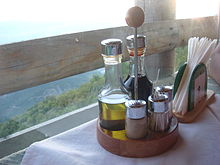
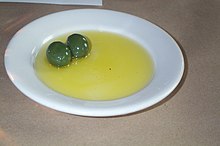
Olive oil is an important cooking oil in countries surrounding the Mediterranean, and it forms one of the three staple food plants of Mediterranean cuisine, the other two being wheat (as in pasta, bread, and couscous) and the grape, used as a dessert fruit and for wine.[22]
Extra virgin olive oil is mostly used as a salad dressing and as an ingredient in salad dressings. It is also used with foods to be eaten cold. If uncompromised by heat, the flavor is stronger. It also can be used for sautéing.
When extra virgin olive oil is heated above 210–216 °C (410–421 °F), depending on its free fatty acid content, the unrefined particles within the oil are burned. This leads to deteriorated taste. Refined olive oils are suited for deep frying because of the higher smoke point and milder flavour.[23] Extra virgin oils have a smoke point around 180–215 °C (356–419 °F),[1] with higher-quality oils having a higher smoke point,[24] whereas refined light olive oil has a smoke point up to 230 °C (446 °F).[1]
Religious use[edit]
Christianity[edit]
The Roman Catholic, Orthodox and Anglican churches use olive oil for the Oil of Catechumens (used to bless and strengthen those preparing for Baptism) and Oil of the Sick (used to confer the Sacrament of Anointing of the Sick or Unction). Olive oil mixed with a perfuming agent such as balsam is consecrated by bishops as Sacred Chrism, which is used to confer the sacrament of Confirmation (as a symbol of the strengthening of the Holy Spirit), in the rites of Baptism and the ordination of priests and bishops, in the consecration of altars and churches, and, traditionally, in the anointing of monarchs at their coronation.
Eastern Orthodox Christians still use oil lamps in their churches, home prayer corners and in the cemeteries. A vigil lamp consists of a votive glass containing a half-inch of water and filled the rest with olive oil. The glass has a metal holder that hangs from a bracket on the wall or sits on a table. A cork float with a lit wick floats on the oil. To douse the flame, the float is carefully pressed down into the oil. Makeshift oil lamps can easily be made by soaking a ball of cotton in olive oil and forming it into a peak. The peak is lit and then burns until all the oil is consumed, whereupon the rest of the cotton burns out. Olive oil is a usual offering to churches and cemeteries.
